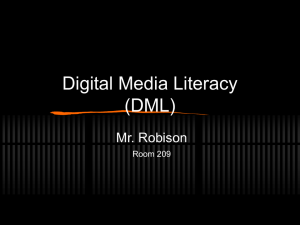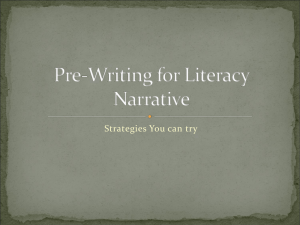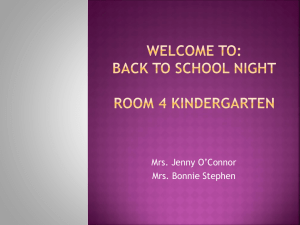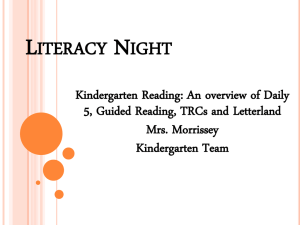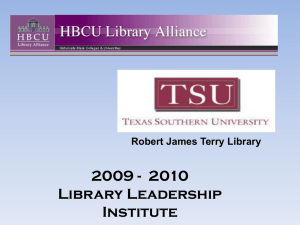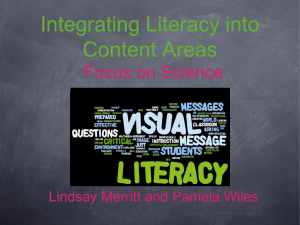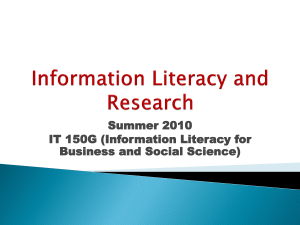Anne McGill-Franzen - Rtl or Responsive Teaching
advertisement
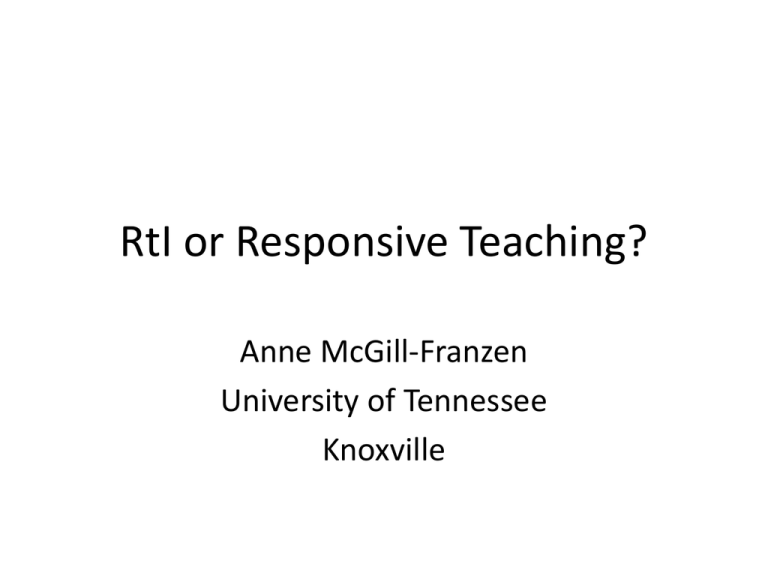
RtI or Responsive Teaching? Anne McGill-Franzen University of Tennessee Knoxville What’s in a name? • Burden is on the child—”treatment resister” • Calls up questionable constructs like “fidelity of implementation” instead of moment-bymoment responsive teaching • Instead of instruction there is a “standard treatment protocol” • Instead of actual observations of reading and writing there are “probes” and “dosage” RtI Assumptions • One prevailing policy assumption- the more standardized the curriculum & pedagogy, better the achievement (more decision making taken out of teachers’ hands) • Opposite assumption here-the more standardized the curriculum & pedagogy, less likely teachers can be responsive to the lowest achieving students Standard Treatment Protocol • Assessment on unidimensional fluency measures • At-risk students given the same commercial program • Fidelity of implementation stressed • Typically monitored by paraprofessional • Assumption that short-term accomplishments are related to broad competence • May narrow curriculum inappropriately • “even in large doses interventions that are focused narrowly on phonemic awareness do not automatically improve reading skills” • May not be the targeted instruction that students need • Allows expert teachers no opportunity to adjust instruction to students’ responses“customization” (Fuchs, 2007) National Institute of Child Health & Human Development Early Childhood Research Network ( Henry & Pianta, 2011; Justice, et al., 2008) • Quality of teachers’ interactions is highly variable • Implementing a set of procedures with fidelity does not impact achievement • Quality is defined by the moment-by-moment interactions within which teachers respond to children’s cues and adjust instruction accordingly What will make a difference in the achievement of vulnerable kids? • Teacher expertise • Collaborative planning • Engaged reading Evidence from Research: 3 Three Examples • Kindergarten Literacy Intervention • Tennessee Successful Schools • Summer Reading Intervention Kindergarten Can Save Lives • IES Issue Brief--Timing & Duration of Special Services in Grades K-3 – Most common entry into special ed is Grade 3 (43%) – Next K (34%) – 1st Grade (23%) • But half (49%) of students who started receiving special services in K stopped receiving these services by Grade 3 • One third (33%) did not need these services in 1st Grade! • Scanlon, Vellutino, et al.(2005, 2006) • Severe reading problems can be prevented with small group instruction focused on “building phonological skills in the context of reading & writing throughout the kindergarten year” • Most children have reading difficulties because of inadequate instruction or experience, not “biologically based causes” Effects of Kindergarten Literacy Last Until 4th Grade--At Least!! “The trace of the kindergarten intervention appears to be as resilient as the one for an intensive 1st grade intervention such as Reading Recovery” [Source: Hiebert & Taylor, 2000; p. 477] Kindergarten Literacy: Practice-Based Model of Teacher Development • THEC Teacher Quality Grant & Great Schools Partnership • Knox County Schools & University of Tennessee • Embedded within long-term district initiatives to improve kindergarten literacy • Local norms • Pilot interventions Project Goals 1. Build teacher capacity in reading through 80 hours of professional development and teaching experience in a modified “clinical practicum” with struggling learners 2. Narrow the literacy gap between children with high entering knowledge of print and those with little knowledge Project Components • Practice-based professional study & collaborative problem-solving to mitigate learning difficulties • Small-group literacy instruction after regular kindergarten day • Videotaped teaching • Curriculum-based monitoring of students’ literacy progress • Extra professional materials, graduate course credit, conference funding opportunities, stipend Project Questions • Should intervention start right away or wait? (Year 1 Pilot) • Do strugglers improve? (Years 1 and 2 ) • What do teachers learn from working with struggling children? (Year 2) • Do all children benefit? (Years 1 and 2) Knox County Schools Demographic • Mid-Sized Southern City –50 Elementary Schools (227 K. teachers) –Approximately 4,500 kindergartners –At beginning of 2005-2006 year: –26% Below Basic on Kindergarten Literacy Assessment (fewer than 7 letters) –31% Advanced (43 letters; 13 sounds) Participating Teachers • 28 Teachers in district-run professional development (no graduate credit) • 12 Teachers and 2 curriculum facilitators in university-run professional development Participating Children • 138 Kindergarten Intervention students • 138 Control students matched on initial letter name and sound knowledge • 200 Project Grad students • 309 Kindergarten students taught by 9 teachers who participated in university pilot across year 1 and year 2 What did teachers do? • Used observation tools • Looked for patterns in kindergartners’ development • Matched instruction to development • Building on strength • Targeting need • Participated in collaborative professional development Observation Tools • Work samples –Writing & spelling records –Oral reading records • Observed behaviors –Sorts –Word reading & writing fluency –Print & book-handling concepts –Voice-print match Good Assessment • Many early childhood advocates equate good assessment with simple kidwatching • Many others equate good assessment with simple letter naming or sound matching fluency • Good assessment must engage kids in real reading and writing tasks to describe where they are--and where they need to go Teachers looked for patterns of early literacy development • • • • “Readers” “Almost readers” “Sounds kids” “Letters & sounds kids” What did teachers do next? Matched instruction to development • Differentiate instruction –Personalize whole-class literacy routines –Identify small groups –Identify kids at risk for intervention • Select teaching strategies & materials • Monitor learning • Adjust instruction & groups Instruction--What did it look like? • Build on the familiar-family, friends, pop culture • Strategy instruction--teacher models, models, models • Manipulative materials for making and breaking words & sentences, sorting and classifying • Literacy used for important work--learning names, writing messages, writing & reading back stories & books, sharing with friends Teacher-to-Teacher Learning “In the beginning I was concerned that I would not be able to help my at-risk students. I was afraid that I would not provide the ‘right’ kind of instruction. Meeting regularly with my colleagues gave me a chance to hear that other teachers were struggling to get some students to remember the simplest highfrequency words, too. Other teachers gave kids books that were too hard, too. I was able to see how other teachers had responded to these challenges. We compared notes. We learned from each other.” Materials are nice, but teachers matter more “Often we are overwhelmed with an abundance of material we don’t know how to use and that may not be appropriate for all my kids!” Using Illustrations Role of Capitalization and Punctuation Directionality and Return Sweep Using Anchor Words Using Initial Letters Reading Spaces Between Words Match to Print Analyses • Series of repeated measures between Kindergarten Intervention students, controls, and Project Grad in Year 2 • Series of repeated measures between all students in participating teachers classrooms in Year 1 and Year 2 • T-test comparisons between Kindergarten Intervention students and controls on TCAPs Total Reading Score in Grade 3 Average Letter Sound Knowledge for At-Risk Students 30 Number of Sounds 25 20 Full Year Intervention 15 Half Year Intervention 10 5 0 Pre Mid Final Text Reading Level Gain Score Results Comparison Students Below A 28% C or Above 16% A or B 56% Kindergarten Intervention Below A 12% A or B 53% C or Above 35% TCAPS? Yes • Significant differences between intervention students and controls • Total Reading Score Teacher Expertise—Did the literacy intervention affect the literacy skills of all children in participating teachers’ classrooms? At-Risk Students Entire Class • Significant differences across years: – Letter Names – Letter Sounds – Spelling – Word Reading – Reading Level – Writing Level • Significant differences across years: – Letter sounds (barely) – Spelling – Word Reading – Reading Level Teachers’ Talk = Teachers’ Beliefs • Teachers decreased discussion of Family and Behavior Attributions in Year 2. – Shifting onus of responsibility for student learning from sources outside the classroom to those over which teacher and student have control. • Teachers increased discussion of Observations of Literacy Development in Year 2. – Demonstrates increased reflection of student literacy knowledge, and reflection of teachers’ own practice. Beliefs About Children’s Learning • Family Attributions • Behavioral Attributions • Observations of Literacy Development • Teaching Observations Sabrina Year 1 Year 2 25% 9% 19% 14% 42% 13% 26% 51% Family Attributions • Family attributions include experience before school if the attribution is that the parents were somehow responsible, descriptions of the family, family dynamics, support provided by the family or lack of “In order to understand the problems that he had you need to know his background his mother was 11 years old when she gave birth to him he was taken away from her he was a full term baby but he stayed in Children’s for 6 weeks….” Behavioral Attributions • Behavioral attributions include observations of behavior typically outside the control of the teacher “He is very good at looking at the other kids and Picking up things watching me figuring out what I’m wanting him to do… I would consider him a risk taker too” Teaching Observations • Teaching includes goal statements, statements about grouping students, activities that students participated in or teachers planned, statements about actual teaching strategies, and quotes from the videos that describe teaching strategies or activities “And we worked on print concepts Shared and guided reading letter names Letter sounds Independent reading Rhyming words Sight words Word families” Literacy Development Observations • Observations about Literacy Development include information from informal assessments, student work, and strategy use by students while reading or writing “That is Jacob…. See how his writing is in the middle and just kind of everywhere? He doesn’t have that concept of directionality, yet you’ll see later how he has mastered left to right….” Summary points— Kindergarten intervention • Students significantly outperformed matched comparison and Project GRAD students on all subtests • Students were less likely be retained in grade or placed in transition classrooms than comparisons • Overall, all students in the classrooms of Intervention teachers performed better over time in Year 2 than in Year 1, suggesting that teachers were becoming more expert at adapting instruction to better support students’ literacy Big Point--Teachers Matter, and they matter most for struggling readers • Converging evidence that in terms of policy, it is most promising to increase teachers’ expertise since teacher variables account for more variance in student achievement • Tennessee Class Size study (Nye, et al., 2004) – Teacher effects were larger than school effects and larger than reducing the class from 25 students to 15 – Most variation in high poverty schools; skilled teachers made biggest difference in achievement Tennessee Successful Schools Project-State Improvement Grant (SIG) Participating Schools (Census: 991 schools) • • • • • • • • 14 of the 21 identified schools participated 12 schools in towns 2 schools in cities PreK or K-4 schools: 5 PreK or K-5 schools: 3 PreK or K-6 schools: 3 PreK or K-8 schools: 3 Enrollment of schools between 300 and 750 Economically Disadvantaged State Average: 54.7% free & reduced lunch • • • • Below the state average: 3 schools Above the state average: 11 schools Lowest percentage in these schools: 42% Highest percentage in these schools: 94% Percent Minority State Average: 32% minority These schools: • Below the state average: 12 schools • At or above the state average: 2 schools • Lowest percentage in these schools: 1% • Highest percentage in these schools: 35% Percent Special Education State Average: 15.4% special education • • • • • These schools: Below the state average: 9 schools At or above the state average: 4 schools Lowest percentage in these schools: 1% Highest percentage in these schools: 25% Qualitative Analysis of Focus Group Responses— “To what do you attribute your school’s success” in literacy ? • • • • Administrators Classroom Teachers Special Education Teachers Parents Case Study: Dolly Parton Elementary • Grades PreK-6 • Demographics – 480 Students – Rural – 78 % Economically Disadvantaged – 95% White; 3.8% African-American; 1% Hispanic Percent of Students Proficient or Advanced in Reading Dolly Parton • All Students 95% • Students with Disabilities 86% • Poor Students 95% State • All Students 90% • Students with Disabilities 70% • Poor Students 86% Dolly Parton: Theme 1 • Access to grade level curriculum with support enabled lowest achieving students to improve The school moved to total inclusion for grades 3-6 The school became school-wide Title 1 thereby gaining two teachers, assistants, and instructional coach Title 1 teachers, assistants, and special education teachers push into classroom to support instruction during reading and language arts blocks Protected time for instruction with 60 minutes for reading and 60 minutes for language arts Dolly Parton: Theme 2 • Collaborative planning enabled adjustments to curriculum The school initiated daily common planning and weekly grade level meetings The instructional coach identified students for intervention based on mastery of SPIs based on TCAP The special education and Title 1 teachers and assistants consulted classroom teachers’ posted plans The special education teacher and classroom teachers monitored students’ progress on reading curriculum assessments Dolly Parton: Theme 3 • Technology programs increased the time students spent reading Two computer labs and classroom mini-labs with Study Island and River Deep software supported 40 minutes extra reading daily AR libraries are located in every classroom Principal: Collaboration that enables student achievement • “We’re looking all the way down, and we’re beginning to see what we can do for all levels of students. And I think that comes through the collaboration that we now have with our teachers…. They want to do the best job they can do and so they’re always looking for that communication…. I think that’s very important” (Dolly Parton Principal). Classroom teacher: Collaboration issues that may subvert success • “I’m planning probably an hour and a half to two hours a day after school or at home just making sure I’m prepared for the next day’s lesson…[and I’m] a veteran teacher you know….I love my intervention teachers but I just don’t understand why they don’t have their own curriculum and why once kids are targeted, they don’t pull them and do a program” (Dolly Parton Classroom teacher). Dolly Parton: Lingering questions • How are planning and teaching responsibilities distributed across classroom teachers, special education and Title 1 teachers, instructional coaches, and assistants? • How is complex “push-in” scheduling managed? • How is classroom instruction differentiated? • Is there an “opportunity cost” with increased use of technology software? Why were these schools successful? • Students spent protected time engaged in reading and related literacy experiences • Teachers collaborated (within and across grade levels; between classroom teachers, specialists, and special education teachers) Why were these schools successful? • An emphasis on using assessment data to plan instruction • Inclusion of most special education students And the 3rd project, making summers count—Engaged reading outside of school “Reading books was the out-of-school activity that proved to have the strongest association with reading proficiency….Time spent reading books was the best predictor of a child’s growth as a reader from the second to the fifth grade.” Source: Anderson, Wilson & Fielding (1988) A- Lower SES students Summer Reading Loss B - Higher SES Students 8.0 7.0 Grade Equivalency 6.0 5.0 4.0 3.0 2.0 1.0 0.0 KS 1F 1S 2F 2S 3F 3S 4F 4S 5F Source:Cooper, H. Charlton, Valentine, J., Muhlenbruck, L. (2000). & Entwisle, D., Alexander, K., & Olson, L.S. (1997). 5S 6F 6S Summer Reading Projects: Increasing access to engaging books “Research clearly shows that the key to stemming summer reading loss is finding novel ways to get books into the hands of children during the summer break.” Source: McGill-Franzen & Allington (2003) One way: Book fairs • The Summer Reading Club was a 3-year study that looked at the effects of providing children from low-income homes with 10-12 free books, self-selected by the children. • Students selected books about topics that are familiar to them from TV, movies and their teachers’ readalouds. FCAT DSS performance p = .015 d = .14 Putting effect size into context • Small effect size (.14) but identical to the Cooper, et al. (2000) meta-analysis of effects of summer school participation • Effect size larger than that reported by Borman, et al. (2003) for adoption of comprehensive school reform model Why was the intervention successful? • Guthrie & Humenick found a huge effect size (1.64) for access to interesting and appropriate texts • Share (1995) hypothesized a self-teaching mechanism -- that reading itself improves reading Benefits of motivational classroom practices for students' reading comprehension and achievement 1.8 1.64 1.6 Effect Size 1.4 1.2 1.2 1 0.87 0.8 0.6 0.48 0.4 0.2 0 Knowledge Goals Student Choices Interesting Texts Collaboration Source: John Guthrie and Nicole Humenick. (2004). Motivating Students to Read: Evidence for Classroom Practices that Increase Reading Motivation and Achievement Another way: Summer school intervention • A substudy of the large FL project was a smaller scale Summer Reading Club study that looked at the effects on reading achievement of a professional development activity focused on fluency, comprehension & self-selected books. • Based on knowledge about students’ interests & learning profiles (failed FCAT & 3rd grade), text sets were developed for readalouds, strategy instruction, and peer collaboration. Top Books • • • • • • • Brittany Spears Hangin’ with Lil’Romeo Scooby Doo Captain Underpants Junie B.Jones The Rock Scary Creatures: Big Cats, Alligators & Crocodiles • Clifford • Superman’s First Flight Series Books: “What makes readers and keeps them reading” • “Reassurance of the familiar” for novice readers • Identification with other readers of the series Rules of Notice & Signification (Rabinowitz, 1998) • Automatic and invisible • Enable understanding and interpretation – Series highly patterned & formulaic – Conventions of reading made explicit – Eases transition into longer stretches of text Noticing character--Junie B. What sort of person is she? • My name is Junie B. Jones. The B. stands for Beatrice. Except I don’t like Beatrice. I just like B. and that’s all. • My teacher sat me next to her on a bench. Her name is Mrs. She has another name too. But I like Mrs. And that’s all. • Grandma Miller leaned down and hugged me. She said don’t call her Helen. Noticing vocabulary-- Captain Underpants • Mrs. Ribble opened the card and read inside: Will you marry me? Signed Mr. Krupp.” Eeeeeeeeeeeeeewww, cried the children. The teachers gasped. • Then the room grew silent. Ms. Ribble glared over at Mr. Krupp, who had turned bright red and began sweating profusely. Series books support beginning readers • Fluency • Repeat many of the same words and refrains • Make shifting perspectives explicit • Stamina • Sustain a story over many pages of text • Engagement • Sustain involvement over multiple books • Link to popular media & kids’ everyday culture And develop comprehension Character • Name • Language • Looks Setting Events • Feature the same characters who act the same way in book after book • Narratives take place in the same or similar settings • Problems resolve in predictable ways Exploratory findings on multiple assessments • Factor analysis identified 3 components-accuracy, fluency, comprehension • Participating students significantly improved in accuracy (d=.31) over controls, but not fluency or comprehension • Participating students modestly improved level of text that they were able to read with teachers’ support (slightly over one GR level) Conclusion– If the goal of RtI is to decrease the number of children who are labeled rather than find them…. • Develop teachers’ expertise through practice-based professional development • Extend responsibility for instructional planning to all teachers of literacy • Institutionalize structures to support coherent planning across areas of professional expertise • Monitor student progress with assessments that make sense • Build engagement with literacy by acknowledging what students want to read as well as what they can read

